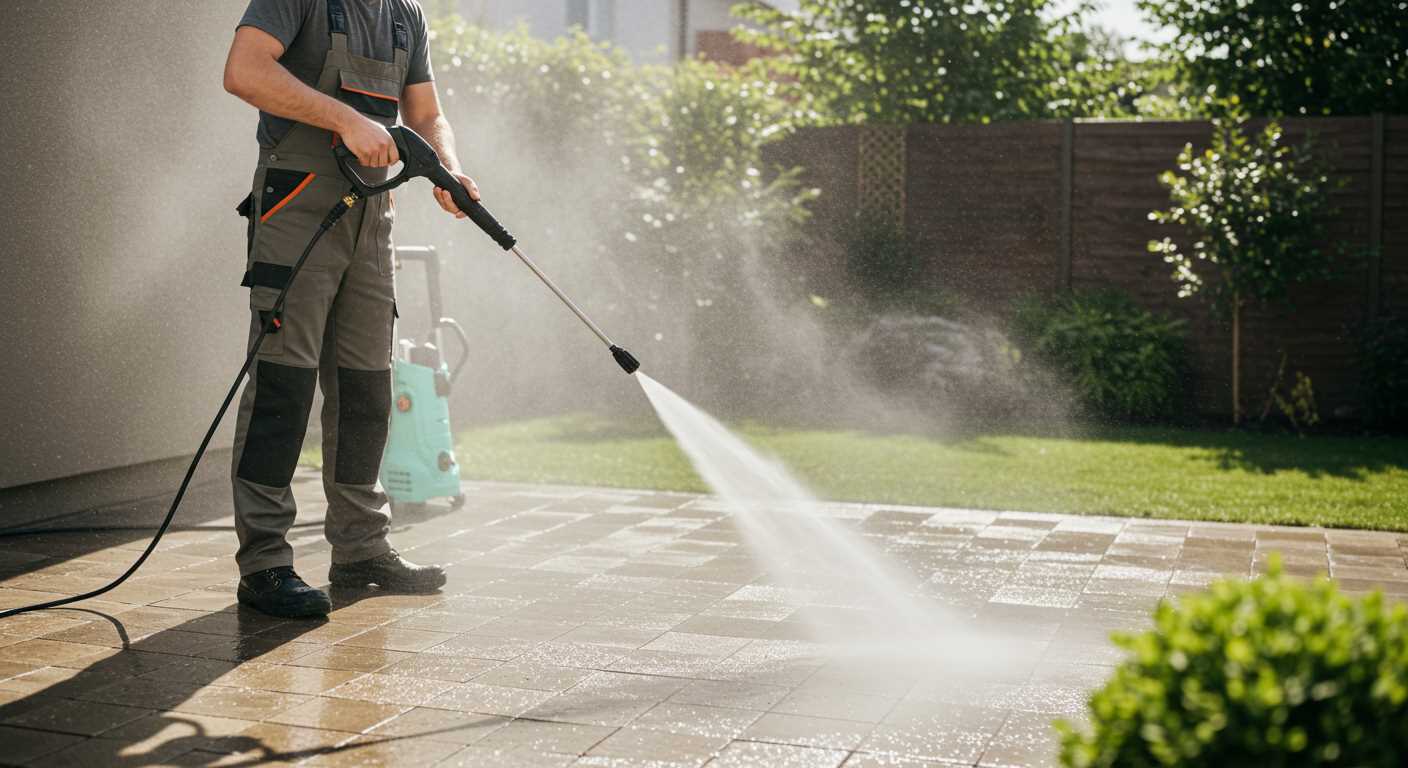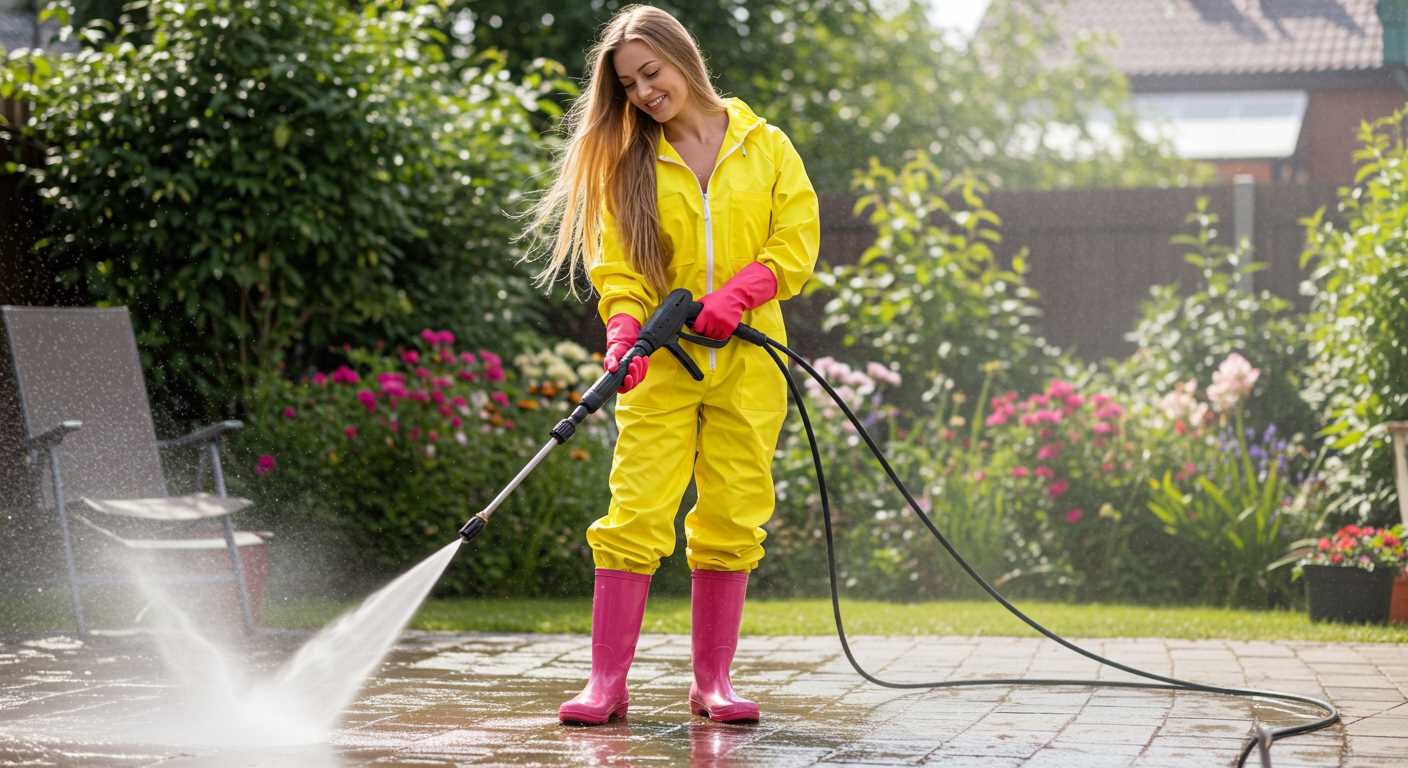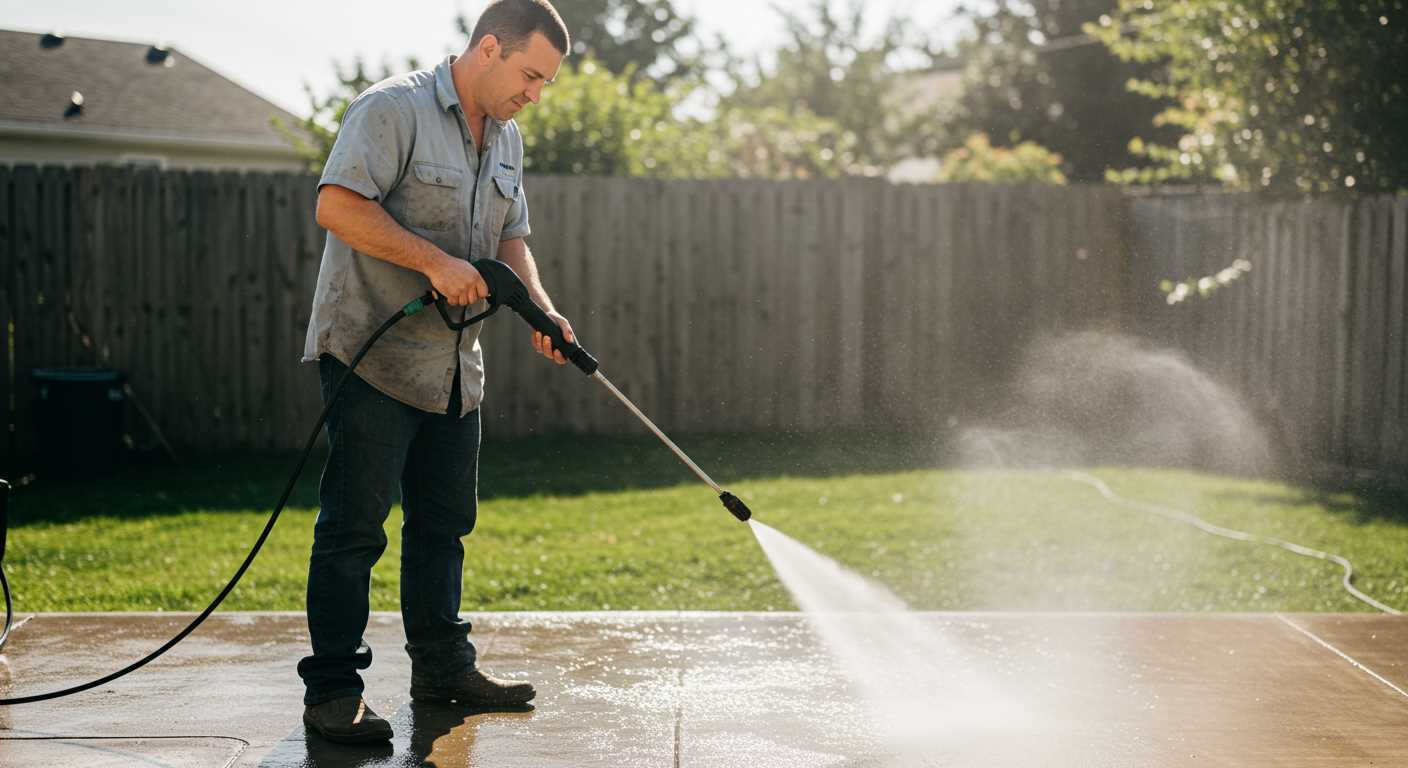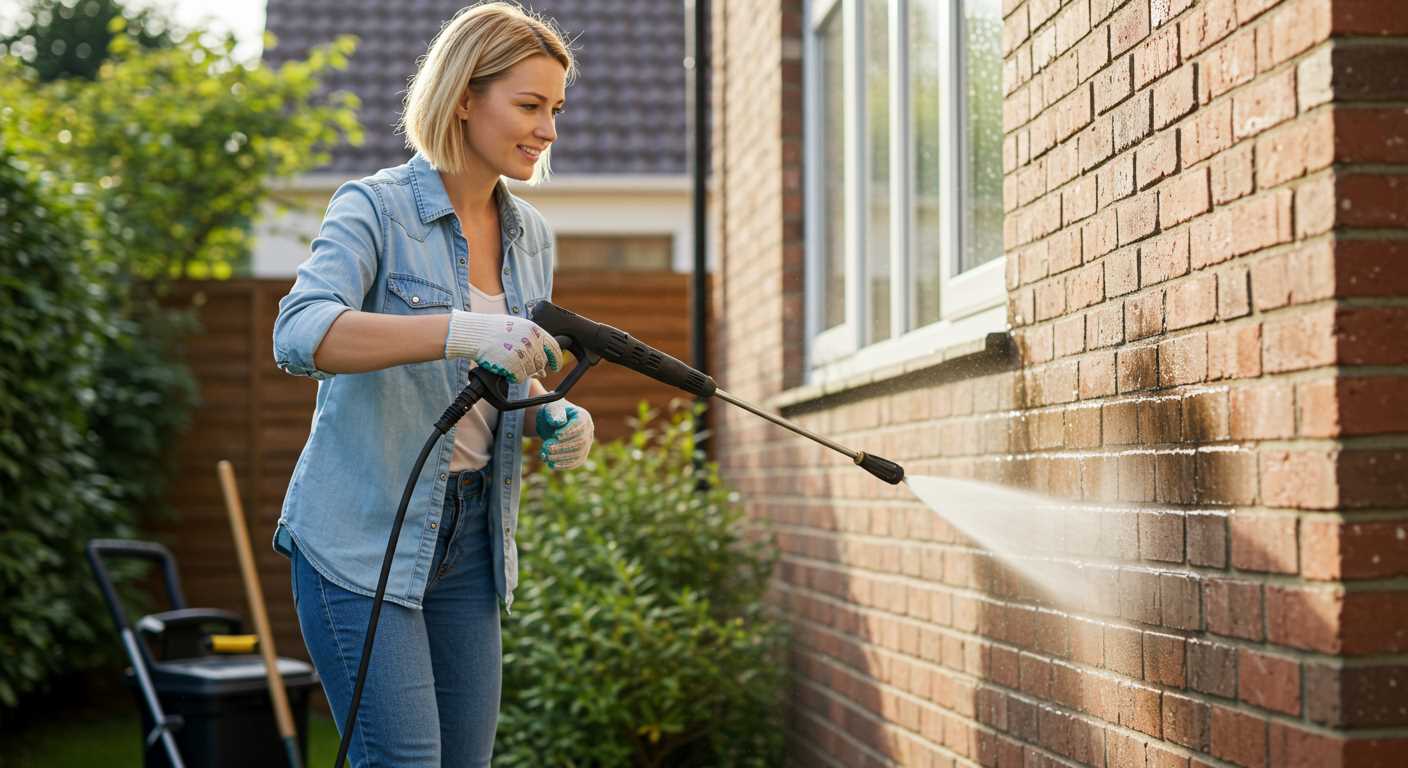



Typically, the reach of a high-pressure cleaner’s jet can extend anywhere from 15 to 30 feet, depending on the model and nozzle used. For optimal outcomes, it’s advisable to maintain a distance of around 6 to 10 feet from the surface being cleaned. This distance allows for maximum cleaning power without damaging the material underneath.
The type of nozzle also plays a pivotal role in determining the range and impact of the water stream. A narrow nozzle increases pressure, allowing for targeted cleaning, while a wider option offers broader coverage but reduces the force exerted upon the surface. I recommend starting with a wider angle for delicate surfaces and switching to a more focused nozzle as needed to tackle stubborn grime.
Additionally, elevate your cleaning capabilities by employing an extension wand, which can often increase reach by several feet, enabling you to access high or distant areas without compromising effectiveness. Regular maintenance of the equipment ensures consistent jet power and optimal performance over time.
Distance Capabilities of High-Pressure Cleaners
The reach of a high-pressure cleaner typically varies between 20 and 30 feet, depending on the model and nozzle used. In certain cases, using a turbo nozzle can extend this range slightly, providing an intensified spray that covers more ground. Selecting the proper attachment is crucial for achieving optimal distances.
For tasks at greater heights, consider investing in an extension wand. These attachments can increase your reach significantly, making it easier to clean upper surfaces without the need for a ladder. A good quality extension wand can add an additional 12 to 24 feet to your total reach.
Water pressure also plays a key role; machines with higher PSI ratings often have enhanced distance capabilities. For instance, units with around 3000 PSI are more adept at maintaining spray distances compared to those with lower ratings. However, keep in mind that higher pressure may require more caution to prevent damage to delicate surfaces.
Wind conditions can impact performance as well. Be mindful of outdoor cleaning on breezy days, as wind can disrupt the trajectory of the water, reducing precision. A calm environment enhances stability and effectiveness, thus allowing the cleaner to perform optimally.
Checking the manufacturer’s guidelines can provide specific information related to maximum distances per model. Experimenting with various nozzles and tips will optimise your results, allowing for tailored cleaning experiences suited to the task at hand.
Understanding Pressure Washer Specifications
When reviewing specifications of cleaning devices, pay close attention to key metrics that impact performance and distance achieved. Some essential features include:
- Flow Rate (GPM): Higher flow rates enable greater coverage, enhancing the ability to perform tasks more efficiently. It’s measured in gallons per minute (GPM). Look for a unit with at least 2.0 GPM for optimal results.
- Pressure Rating (PSI): This figure determines the force exerted on surfaces. Units with a rating above 2000 PSI are generally more effective for tougher grime and stains.
- Nozzle Types: The variety of nozzles influences the spray pattern. A narrow nozzle increases pressure and reach, while a wider angle spreads the water further but with less intensity.
Understanding these specifications aids in selecting the right model for specific tasks. For instance, if targeting wide surfaces like driveways, opt for equipment with a balanced GPM and PSI for broader reach without sacrificing effectiveness.
Also, consider the design aspects:
- Hose Length: A longer hose provides better accessibility, allowing for extended reach without needing to move the machine frequently. Aim for at least 25 feet.
- Weight: Heavier models may offer stability but can be cumbersome. Evaluate if portability or stability aligns better with your needs.
Investing time into understanding these specifications will significantly enhance your experience, ensuring you select the best suited device for achieving impressive results in cleaning tasks.
Factors Influencing Spray Distance

The nozzle type significantly affects the distance at which the fluid reaches. A narrow jet nozzle channels the force into a concentrated stream, resulting in increased reach. Conversely, a wider spray pattern disperses the fluid, reducing the effective distance.
The output pressure plays a crucial role. Higher pressures produce more force, propelling water further. Most models typically range between 1,300 to 3,000 PSI, and selecting a unit with higher specifications can yield more effective results.
The flow rate, measured in litres per minute (LPM), also contributes. Equipment with a higher LPM can deliver more volume, providing better coverage, which complements the pressure for optimal distance.
Environmental conditions must not be overlooked. Wind can alter the path of the fluid, reducing accuracy and reach. Additionally, factors like terrain and surface condition can hinder the effectiveness of the stream. For example, uneven ground may absorb some of the momentum.
A well-maintained unit is paramount. Regular checks ensure no blockage occurs in hoses or nozzles, which can hinder performance and reduce distance. Similarly, the quality and condition of the hoses play a role; frayed or damaged hoses can lead to pressure loss.
Lastly, the distance from the target impacts results. Maintaining an optimal range, usually between 2 to 4 feet, allows for maximum impact and enhances cleaning efficiency. Understanding these factors allows for more effective use of the equipment, ensuring achieved results meet expectations.
Comparing Different Nozzle Types
The choice of nozzle significantly impacts the reach and impact of the cleaning stream. The most common types include the zero-degree, fifteen-degree, twenty-five-degree, and forty-degree nozzles. Each serves different purposes, influencing the intensity and distance of the jet.
The zero-degree nozzle delivers a concentrated stream, ideal for heavy-duty tasks like removing graffiti. However, its narrow focus means that while it achieves high pressure, it requires you to be closer to the target, often limiting distance.
The fifteen-degree variant strikes a balance between concentrated power and a wider spray. This option allows for medium-range cleaning of driveways and sidewalks, with a more extensive pattern that can cover larger areas without sacrificing too much pressure.
For more general cleaning, the twenty-five-degree nozzle optimises coverage while reducing the risk of damage to more delicate surfaces. This type typically reaches farther than the previous nozzles, making it suitable for surfaces such as decks and patios.
The forty-degree nozzle provides the widest spray pattern, perfect for delicate tasks like washing cars or outdoor furniture. Its design prioritises distance, allowing the water jet to be effectively dispersed over larger areas, ensuring even cleaning.
Choosing the right nozzle involves considering both the distance needed and the type of surface addressed. Testing various types can reveal the most suitable choice for specific cleaning tasks, making it easier to achieve desired results efficiently.
Impact of Water Flow Rate on Spray Range

For maximising distance, opt for a flow rate of at least 2.5 GPM (gallons per minute). This volume not only enhances reach but also ensures effective cleaning by sustaining pressure. Models delivering lower rates struggle to achieve significant distances, often leaving surfaces inadequately treated.
At 3 GPM, one can expect an operational radius that exceeds 30 feet, depending on the nozzle used. Higher flow rates propel water more efficiently, diminishing the impact of gravitational pull, thus extending the trajectory. The balance between pressure and flow is pivotal; a unit offering high PSI but low GPM will result in a narrow and less effective coverage.
While testing various units, I noticed that configurations with adjustable flow settings allow users to customise the output based on the application. For general cleaning tasks, a mid-range flow is sufficient, whereas intensive jobs call for maximum capacity.
Be aware that usage of specific nozzles, like the 0-degree or 15-degree types, reduces the effective range despite higher flow rates. These designs concentrate water into a tight stream, which can be powerful yet may sacrifice reach. Conversely, fan-pattern nozzles spread water over a larger area at the cost of intensity, impacting how far the water travels.
Thus, the ideal combination of flow rate and nozzle selection defines the overall range achieved. For optimal results, evaluate both elements to fit specific cleaning requirements effectively.
Optimal Pressure Settings for Maximum Reach
To achieve the best distance with your cleaning device, set the pressure between 2000 and 3000 PSI. This range balances force and control, allowing effective dirt removal while minimising surface damage. Higher pressure can lead to too much force, potentially damaging delicate surfaces, while lower settings may not provide the reach you seek.
Adjusting Pressure for Different Tasks
When cleaning tougher surfaces like concrete or brick, you might increase the pressure closer to 3000 PSI for maximum effectiveness. For gentler tasks, such as washing cars or house siding, reduce the pressure to around 1500 to 2000 PSI to protect the surface. The nozzle choice also influences the results–narrower angles typically deliver higher impact, whereas wider angles offer a broader reach with less power.
Importance of Consistent Water Source

A reliable water supply is crucial to maintain optimal settings. Insufficient flow can inhibit distance and performance. Aim for at least 2.5 gallons per minute (GPM) to ensure efficient operation and maintain the desired impact. Test the setup regularly to guarantee that both pressure and flow are sufficient to meet your cleaning needs.
Real-World Applications of Pressure Washer Distance
The reach of cleaning equipment varies significantly across different scenarios. Applications in both residential and commercial settings leverage this capability effectively. For example, residential users can address high areas like roofs and exterior walls from a safe distance, while professionals in industrial settings might clean large vehicles or machinery without needing to get dangerously close. This versatility is invaluable across sectors.
Residential Uses

Homeowners often deploy these devices to maintain patios, decks, and driveways. When using a heightened nozzle, the effective distance for cleaning can exceed 20 feet, enabling treatment of grime on upper surfaces with minimal ladder use. Such an efficient range makes it feasible to tackle tough jobs quickly, ensuring proper maintenance and aesthetics without unnecessary physical strain.
Commercial and Industrial Applications
In commercial settings, extended reach allows for the washing of structures and vehicles where close access is impractical. For instance, service stations and warehouses utilise these machines for deep cleaning, benefiting from the ability to operate from a distance without compromising cleaning quality. The AR (articulating reach) attachments enhance versatility even further, enabling a broad spectrum of cleaning tasks to be performed from a distance.
| Application | Typical Reach |
|---|---|
| Residential (roofs, walls) | Up to 25 feet |
| Commercial (vehicles, structures) | 15-20 feet |
| Industrial (heavy machinery) | 10-15 feet |
Utilising the optimal settings and configurations, it is entirely possible to maximise the coverage area, making it easier to undertake a broader range of tasks efficiently. Understanding the specifics of reach not only enhances cleaning efficacy but also aids in safety and accessibility during various operations. Each application demands consideration of the right equipment to ensure the task is completed effectively.
Maintaining Your Equipment for Consistent Performance
Regular upkeep is key to achieving maximum output and longevity from your cleaning tools. Here are several effective strategies:
Scheduled Maintenance Checks
.jpg)
- Perform checks every 20 hours of use or at least once per month.
- Inspect hoses and connections for leaks or wear.
- Clean and replace filters as necessary to ensure optimal water flow.
- Examine the spray gun and nozzle for blockages or damage.
Storage Practices
- Store in a dry, sheltered environment to prevent rust and degradation.
- Drain any remaining water to prevent freezing or corrosion in colder climates.
- Use protective covers to shield against dust and debris.
Utilising the right detergent is another factor; always refer to your manufacturer’s guidelines. Incorrect cleaning agents can lead to damage. Additionally, make sure to regularly check the performance of your engine and pump, as these components are critical to maintaining the unit’s efficiency.
Invest in a quality pressure gauge to monitor output settings. Keeping track of these metrics ensures your equipment is operating within optimal parameters. Following these maintenance practices not only enhances performance but also extends the life of your machinery.










